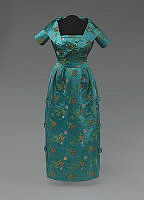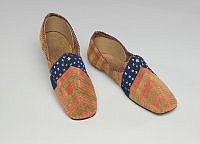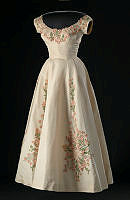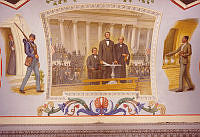Rubenstein Center Scholarship
The Enslaved Household of President John Quincy Adams
This article is part of the Slavery in the President’s Neighborhood initiative. Explore the Timeline
I abhorred slavery [and] did not suffer it in my family
Of the first seven U.S. presidents, John Quincy Adams (JQA) and his father John Adams were the only two who did not bring enslaved people into the White House. At least, that’s the story that most people know.1 In John Quincy Adams’ case, the truth may be more complicated. Although his long fight against Congress’ “gag rule” later earned him a reputation for personally opposing slavery, it was impossible to escape the institution in early nineteenth-century Washington, D.C.2 Everyday life in the nation’s capital relied heavily upon enslaved labor. Click here to learn more about the households of President John Adams.
John Quincy Adams’ family was no exception. His wife, Louisa Catherine Adams, was born in and grew up in London, but her father’s family lived in Maryland and many of them owned enslaved people. Louisa did not necessarily endorse slavery, but she at least tolerated it. When the Adamses first arrived in Washington in 1803, they lived with Louisa’s sister Nancy and her husband Walter Hellen in Georgetown. The Hellens owned several enslaved individuals, but if the Adamses had a problem being waited on by enslaved servants, they left no record of it.3 Louisa’s widowed mother, Catherine, also lived with the Hellens along with the four enslaved people she had inherited from her husband, Joshua Johnson.4
When the Adamses returned to Washington, D.C. in 1817 after a nine-year diplomatic mission abroad, slavery had expanded into most homes across the city as the District was a thriving hub for the domestic slave trade. During JQA’s tenure as secretary of state, he was surrounded by enslaved people. The Adamses first rented a home at F and 4 ½ Streets, one block from the Washington jail that served as a prison and slave pen. In 1820, they purchased a home at 244 F Street, previously occupied by President James Monroe. William and Anna Thornton, a wealthy slave-owning couple and close friends of the Adamses, lived right across the street. Lafayette and Miller’s Taverns were located on the same block. These taverns were frequented by slave traders and had gained notoriety a few years prior when an enslaved woman purchased by a trader had attempted suicide by leaping from a third floor window to avoid being sold south. The Adamses also attended parties hosted by many prominent southern slave-owning families, including the Tayloes and Calhouns—parties made possible by enslaved labor.5 Click here to learn more about the enslaved households of President James Monroe.

This photograph of Monroe House was taken by Bruce White for the White House Historical Association on June 15, 2011. Built in 1802, President James Monroe and family stayed in this home while he was secretary of state and then six months into his presidency while the White House was being restored. The federal style residence named in honor of Monroe is now home of the Arts Club of Washington.
White House Historical AssociationAs John Quincy Adams rose through the ranks of American politics, his wife’s familial connections to slavery continued to follow him. At this point, JQA’s objections to slavery appeared to be mostly political rather than moral. He hated the partisan power of the “slaveocracy” and vigorously protested the gag rule, but as long as traders and owners acted lawfully, he did not object to enslaved workers waiting on him at his friends’ and family’s homes.6 Although he later claimed that he “abhorred slavery” and did not allow it in his family, there is considerable evidence to suggest that Adams relied on enslaved labor even during his White House years.
Nancy Hellen died in 1810. Her husband Walter married Nancy and Louisa’s youngest sister Adelaide in 1813, but then passed away himself in 1815. He left behind four children – Johnson (age 15), Mary Catherine (9), and Thomas (6) from his first marriage, as well as baby Walter Jr. (1) from his second. Although Walter’s friend Thomas Cook was appointed legal guardian and executor of Walter’s estate, some of the Hellen children ultimately went to live with their aunt Louisa and her husband John Quincy Adams. On November 2, 1817, JQA wrote in his diary that “my wife brought home with her Mary Hellen her eldest sister’s daughter, whom she takes to live with us.”7 This apparently occurred because Adelaide Hellen was ill, but Mary stayed with the Adamses until she was an adult, long after her mother recovered. Her brother Johnson Hellen lived with the family off and on throughout the 1820s. The family’s letters and diary entries indicate that he came into their home in November of 1820, lived there until July 1822, and moved back again in April 1826, by which time the family was living in the White House.8 In the interim, he lived and practiced law in nearby Rockville, Maryland, and visited frequently. Thomas eventually joined the Adams household as well, although he was away at boarding school for most of the year.9
Walter Hellen’s will dictated that a portion of his wealth be applied toward the “maintenance and education” of his children until they came of age.10 John Quincy Adams would certainly have received disbursements from that estate for housing, feeding, and clothing the Hellen children. Hellen’s fortune was built in part on the labor of enslaved people, but if Adams had any qualms about taking a slave owner’s money, he never publicly expressed them. However, the money was not all that the young Hellens brought with them from their father’s estate. Substantial evidence suggests that they were accompanied by at least a few enslaved servants, including during the years they lived at the White House.

Slavery was ubiquitous and inescapable during the Adams family’s tenure in Washington, D.C. This Civil War-era photograph shows a slave-trading operation in Alexandria, VA, less than ten miles from the White House. During John Quincy Adams’ presidency, this building housed the offices of Franklin and Armfield, the largest dealer of enslaved people in the United States.
The best documentation of enslaved individuals living and working in the John Quincy Adams White House all date from three days in late February of 1828. On February 23, JQA wrote in his diary that "Holzey, the black boy belonging to Johnson Hellen, and who has been several years with us, died about five o’clock this afternoon. He has been sinking several months in a consumption.”11 It is possible that Holzey was a hired servant but if that was the case, Adams would probably have not used the word “belonging”. The most likely explanation is that he was enslaved. Johnson Hellen’s 1830 census entry shows two enslaved people in his household, so he clearly was not averse to owning human property.12 What is surprising is Adams’ apparent comfort with the idea of an enslaved person spending “several years” under his roof.
On February 24, Adams mentioned Holzey again. “Johnson Hellen’s black boy was buried,” he wrote in his diary.13 Again, the choice of language implies ownership, not employment. He followed that brief mention with a few lines of Latin poetry from the Roman poet Horace. The verse reflects on how death comes equally for paupers and kings.14 The inclusion of this snippet at the end of the day’s diary entry suggests some genuine emotion over Holzey’s death. If he had waited on Johnson Hellen while living with the Adamses, Holzey would have spent several years in close proximity to the family. JQA may have developed a sincere affection for the man. The point remains, though, that while Adams never owned enslaved people and is considered by many an antislavery president, he appears to have permitted slavery under his own roof.

John Quincy Adams’ diary entry for February 23, 1828, wherein he notes the death of Holzey, “the black boy belonging to Johnson Hellen.”
Collection of the Massachusetts Historical SocietyThe next day, slavery resurfaced in JQA’s life again, but this time he avoided mentioning it in his diary. On February 25, Mary Catherine Hellen married John Adams II, the middle son of Louisa and John Quincy Adams. On the day of her wedding, she filed manumission papers for an enslaved woman named Rachel Clark.15 Rachel had probably been with Mary throughout her time in the Adams household. The 1820 census entry for John Quincy Adams’ family included one enslaved girl under the age of fourteen.16 It was common for children of slave-owning families to be given an enslaved servant around their own age when they were young. The hope was that growing up together would create a bond and produce a relationship built on affection and loyalty.17 Mary Catherine Hellen was fourteen years old in 1820, so the age of the unnamed enslaved girl fits with this theory. If the girl on the 1820 census was Rachel Clark, then she probably lived with Mary at the Adams residence for the intervening eight years, if not longer. That would mean that for almost a decade, John Quincy and Louisa Adams permitted the forced labor of an enslaved child within their home.
So why did Mary Catherine free Rachel Clark on the day of her marriage? It is possible that she simply wanted to do so. The moderate antislavery views of her Massachusetts relatives might have rubbed off on her. However, the timing of the manumission, on the very day of her wedding, suggests another possibility. Her new husband or father-in-law might have asked her to free Rachel. Both Louisa Catherine and John Quincy Adams were not thrilled with their son’s choice of spouse and they could even have made it a precondition of the marriage. Neither of John Adams II’s brothers, George Washington and Charles Francis Adams, attended his wedding, perhaps because both had courted Mary Catherine before she turned to John Adams II. Louisa Catherine wrote to Charles describing the wedding and revealing her dislike of her daughter-in-law: “Madame is cool easy and indifferent as ever.”18 Rachel’s presence up to that point makes it clear that John Quincy Adams was willing to tolerate slavery in his household, but bringing an enslaved person into his own son’s family might have been a step too far.

John Quincy Adams’ diary entry for February 24, 1828. He writes that “Johnson Hellen’s black boy was buried,” followed by a few lines of Latin verse.
JQA may have also been worried about the optics of slavery in his White House. During the campaign of 1824, JQA’s supporters highlighted Andrew Jackson’s involvement with slavery. Andrew Erwin, an Adams ally, published a pamphlet accusing Jackson of “trafficking in human flesh.” Another pamphlet alleged that Jackson had ordered his overseer to whip a runaway slave, Gilbert, to death. While Jackson did not whip Gilbert himself, his actions left “the blood of this human being [on the escutcheons of the Hermitage.”19 JQA’s antislavery views gave him some semblance of a moral high ground, but this advantage with voters dissipated quickly as Jackson’s supporters countered with charges of elitism and corruption. These allegations followed JQA into office and were revived when John Adams II, serving as his father’s private secretary, purchased a billiards table and chess set with government funds.20 Since John Adams II seemed to be an easy target already, JQA may have wished to avoid giving his Jacksonian enemies more political ammunition. Click here to learn more about the enslaved households of President Andrew Jackson.
It is also possible that Mary Catherine Hellen may not have legally been allowed to free Rachel Clark until either her marriage or her twenty-first birthday, which had come just five months before the wedding. Rachel had probably been part of Mary’s inheritance when Walter Hellen died. Mentions of “cash, furniture, and negroes” in estate paperwork suggests this, as does the presence of an enslaved woman named Jane Clark in the household of Adelaide Hellen – probably a relative of Rachel’s.21 Rachel Clark was legally property, and if that property was part of Walter Hellen’s estate then there could have been restrictions on how it was used. The complex property laws of the early nineteenth century add another speculative dimension to the question of slavery in the John Quincy Adams White House.
Walter had designated his friend Thomas Clark as the executor of his will and legal guardian of his children. Adelaide Hellen was still alive, but a woman could not legally serve as the children’s guardian in this context. Walter Hellen’s will made some specific stipulations about his home and furniture, but then provided that “the rest & residence of my Estate, both Real and Personal, to be equally divided among my children” when they “become of lawful age,” typically twenty-one-years-old.22 The enslaved people owned by Hellen are not mentioned elsewhere in the will, so presumably they were part of this general division of property. Until they came of age and into their full property rights, the Hellen children may not have had the legal authority to free those enslaved individuals, even if they were actively making use of their labor.

This portrait of First Lady Louisa Catherine Johnson Adams was painted by prolific portraitist Gilbert Stuart between 1821 and 1826. Mrs. Adams first sat for the portrait when her husband, John Quincy Adams, served as secretary of state for President James Monroe, and it was finished during Adams' presidency, which began on March 4, 1825 and ended on March 4, 1829.
White House Historical Association/White House CollectionEven beyond the age of twenty-one, the situation remains murky. Adelaide Hellen was given an unusually small share of her husband’s estate, so she successfully sued for a larger share, which would have altered the distribution of Walter’s fortune.23 Her traditional dower rights could also have given her some control over her husband’s estate until her death in 1877. Moreover, the youngest of Hellen’s orphans, Walter Jr., did not come of age until 1835. JQA’s diary entry for April 21 of that year mentions the “final settlement of the Estate of the former Walter Hellen and the distribution of his property between his surviving children.”24 If the estate could not be truly settled until 1835, it is possible that Mary and Johnson did not have full latitude to decide what to do with their enslaved property until that time. Property rights also shifted upon marriage, which might explain Mary Hellen’s wedding-day manumission of Rachel Clark.
No matter the specifics of the property rights, Mary and Johnson Hellen (and by extension John Quincy Adams and the rest of the household) likely participated in the institution of slavery. The Hellen children might not have had the legal right to free their enslaved property when they were young, but that did not mean they had to continue to utilize their labor. It is possible, although not likely, that they allowed Holzey and Rachel to come and go freely or to find paid employment. It is also possible that the Hellen estate paid Holzey and Rachel wages for their labor. Unfortunately, we do not have any documentation that details how they were treated while they were at the White House and no records exist to suggest they received wages from the estate. As the children of a slave owner who had grown up with enslaved servants, Mary and Johnson Hellen probably saw nothing wrong with continuing this arrangement. John Quincy Adams’ acceptance of the situation is perhaps more surprising. Why did a man who would go on to rail against the pro-slavery “gag rule” accept the presence of enslaved laborers in his own home?25
One answer is that the President’s House was fundamentally set up to rely on enslaved labor. John Quincy Adams was the first president who did not own enslaved people to live in the White House for any substantial length of time. His father, John Adams, lived there for only four months. Every other president since had brought enslaved people to the Executive Mansion. The White House required a substantial staff to operate at the level that Washington society expected, but at the time there were no appropriated funds to pay for household staff. The president was expected to use his annual salary of $25,000 to cover these costs. That was a lot of money in 1825, but once the president had paid for food, wine, entertainment, décor and additional furnishings, and his own family’s needs, the funds remaining for housing and paying staff was rarely sufficient. Only an extraordinarily wealthy person could afford to staff the house without enslaved labor. While it is possible JQA paid Holzey and Rachel for their work, we have uncovered no evidence to suggest money changed hands. Whatever John Quincy Adams’ principles might have been, the reality was that the enslaved individuals inherited by his niece and nephew likely offered a relationship of convenience—he did not have to purchase them, he did not have to pay someone for their labor, and he avoided hiring additional wage-earning servants.

This watercolor painted in 1827 by an anonymous artist, depicts the White House and its grounds from the southwest. The watercolor shows the recently built South Portico, constructed in 1824 during the Monroe administration, Thomas Jeffersons stone walls, workers cottages, an orchard, and President John Quincy Adam's tree nursery.
Anthony St. John Baker, Memoires d'un voyageur qui se repose: With illustrations.... (London: Priv. print., 1850), RB 286000, The Huntington Library, San Marino, California "President's House, Washington";White House and Capitol, c. 1826 [watercolor]Walter Hellen’s will and other relevant documents do not enumerate how many enslaved people were part of the estate. There is every possibility that Rachel and Holzey were not the only people passed down from the late Walter Hellen to his children. Unfortunately, the historical record tells us little else about the lives of Holzey and Rachel Clark, or about any other enslaved people brought into the White House by the Hellen siblings. What we do know is that even as John Quincy Adams claimed to abhor slavery and forbid it in his family, enslaved people lived at the White House during his presidency. JQA’s conundrum was not a unique one. Countless families across the country found themselves in similar situations by marrying into families that held different views of slavery than their own. In most cases, they permitted the continuation of slavery in their homes and justified their participation as an acceptable allowance because they had not purchased the individuals themselves.
Yet, by the end of his life, JQA was known as a vocal opponent of slavery. Historian Alison Mann has compellingly demonstrated that JQA considered slavery, and his hatred of the institution, as a theoretical, political issue until he came face-to-face with the worst atrocities of the slave trade. On October 28, 1837, JQA visited Edward Dyer’s auction house after reading unusual notices advertising an upcoming slave auction of an enslaved woman, Dorcas Allen, and her two daughters, Mary Allen and Margaret Allen. JQA witnessed Dorcas and her children “weeping and wailing most piteously,” and learned that Dorcas’s husband, Nathan Allen, was desperately trying to raise money to purchase his family’s freedom and prevent their impending separation.26 Moved by the scene, JQA agreed to contribute $50.00 toward the purchase if Allen could raise the remaining funds.27
In John Quincy Adams’ case, the truth may be more complicated.
Over the next few weeks, JQA was haunted by the case and spent hours investigating the legal nuances and questioning witnesses. He was plagued by the personal pleas of Dorcas and her family, but also the illegal and immoral activity of the traders and auctioneers. After Allen visited him several times, JQA handed over the promised check for $50.00 on November 13. JQA’s contribution to the sale was recorded a few years later in the District’s Free Negro Registers: “Dorcas Allen, aged thirty-one years; her daughter Mary Allen, aged about twelve years; and Margaret Allen, aged about nine years...[Smith, the owner] acknowledges that he received from Nathan Allen, a free black man, the sum of $175 in bank notes and a check for fifty dollars from John Q. Adams.”28
While JQA left no comment about Dorcas’ freedom in his diaries or letters, his public actions suggest the episode had a lingering influence on his antislavery position. Just two years after Dorcas’ sale, JQA was again outraged at illegal and immoral behavior by slave traders and successfully represented the captured Africans in the Amistad case by arguing in front of the Supreme Court and securing their freedom and passage home.
Thanks to Dr. Alison Mann, Public Historian at the National Museum of American Diplomacy, and Dr. Neal Millikan, Series Editor of the Adams Papers at the Massachusetts Historical Society, for their help and expertise on this article.










